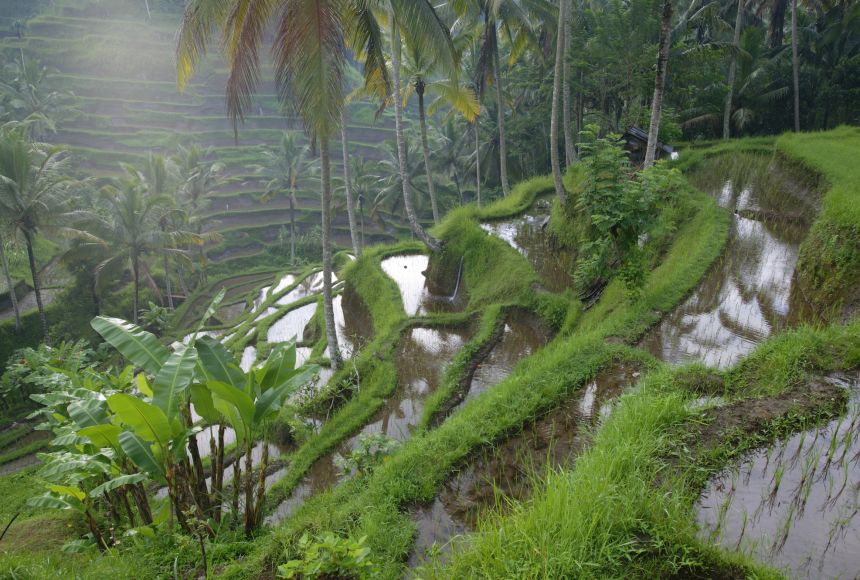Agricultural methods have intensified continuously ever since the Industrial Revolution, and even more so since the “green revolution” in the middle decades of the 20th century. At each stage, innovations in farming techniques brought about huge increases in crop yields by area of arable land. This tremendous rise in food production has sustained a global population that has quadrupled in size over the span of one century. As the human population continues to grow, so too has the amount of space dedicated to feeding it. According to World Bank figures, in 2016, more than 700 million hectares (1.7 billion acres) were devoted to growing corn, wheat, rice, and other staple cereal grains—nearly half of all cultivated land on the planet.
In the coming decades, however, meeting the demand for accelerated agricultural productivity is likely to be far more difficult than it has been so far. The reasons for this have to do with ecological factors. Global climate change is destabilizing many of the natural processes that make modern agriculture possible. Yet modern agriculture itself is also partly responsible for the crisis in sustainability. Many of the techniques and modifications on which farmers rely to boost output also harm the environment. Below are brief descriptions of three ways intensive agriculture threatens the precarious balance of nonagricultural ecosystems.
Irrigation
Worldwide, agriculture accounts for 70 percent of human freshwater consumption. A great deal of this water is redirected onto cropland through irrigation schemes of varying kinds. Experts predict that to keep a growing population fed, water extraction may increase an additional 15 percent or more by 2050. Irrigation supports the large harvest yields that such a large population demands. Many of the world’s most productive agricultural regions, from California’s Central Valley to Southern Europe’s arid Mediterranean basin, have become economically dependent on heavy irrigation.
Researchers and farmers alike are becoming increasingly aware of the consequences of this large-scale diversion of freshwater. One of the most obvious consequences is the depletion of aquifers, river systems, and downstream ground water. However, there are a number of other negative effects related to irrigation. Areas drenched by irrigation can become waterlogged, creating soil conditions that poison plant roots through anaerobic decomposition. Where water has been diverted, soils can accrue too much salt, also harming plant growth. Irrigation causes increases in water evaporation, impacting both surface air temperature and pressure as well as atmospheric moisture conditions. Recent studies have confirmed that cropland irrigation can influence rainfall patterns not only over the irrigated area but even thousands of miles away. Irrigation has also been connected to the erosion of coastlines and other kinds of long-term ecological and habitat destruction.
Livestock Grazing
A huge amount of agricultural territory is used primarily as pasture for cattle and other livestock. In the western United States, counting both federally managed and privately owned grazing lands, hundreds of millions of acres are set aside for this purpose—more than for any other type of land use. Agricultural livestock are responsible for a large proportion of global greenhouse gas emissions, most notably methane. In addition, overgrazing is a major problem regarding environmental sustainability.
In some places, stretches of forage land are consumed so extensively that grasses are unable to regenerate. The root systems of native vegetation can be damaged so much that the species die off. Near streambeds and in other riparian areas where cattle concentrate, the combination of overgrazing and fecal wastes can contaminate or compromise water sources. Cattle and other large grazing animals can even damage soil by trampling on it. Bare, compacted land can bring about soil erosion and destruction of topsoil quality due to the runoff of nutrients. These and other impacts can destabilize a variety of fragile ecosystems and wildlife habitats.
Chemical Fertilizer
Synthetic fertilizers containing nitrogen and phosphorus have been at the heart of the intensified farming from World War II to the present day. Modern agriculture has become heavily dependent on these chemical inputs, which have increased the number of people the world’s farms can feed. They are particularly effective in the growing of corn, wheat, and rice, and are largely responsible for the explosive growth of cereal cultivation in recent decades. China, with its rapidly growing population, has become the world’s leading producer of nitrogen fertilizers.
While these chemicals have helped double the rate of food production, they have also helped bring about a gigantic increase, perhaps as high as 600 percent, of reactive nitrogen levels throughout the environment. The excess levels of nitrogen and phosphorus have caused the once-beneficial nutrients to become pollutants. Roughly half the nitrogen in synthetic fertilizers escapes from the fields where it is applied, finding its way into the soil, air, water, and rainfall. After soil bacteria convert fertilizer nitrogen into nitrates, rainstorms or irrigation systems carry these toxins into groundwater and river systems. Accumulated nitrogen and phosphorus harm terrestrial and aquatic ecosystems by loading them with too many nutrients, a process known as eutrophication. Nutrient pollution is a causal factor in toxic algae blooms affecting lakes in China, the United States, and elsewhere. As excessive amounts of organic matter decompose in aquatic environments, they can bring about oxygen depletion and create “dead zones” within bodies of water, where nothing can survive. Parts of the Gulf of Mexico are regularly afflicted in this manner. Nitrogen accumulation in water and on land threatens biodiversity and the health of native plant species and natural habitats. In addition, fertilizer application in soil leads to the formation and release of nitrous oxide, one of the most harmful greenhouse gases.
With the global population continuing to skyrocket, the tension will continue to grow between continued agricultural growth and the ecological health of the land upon which humans depend.


